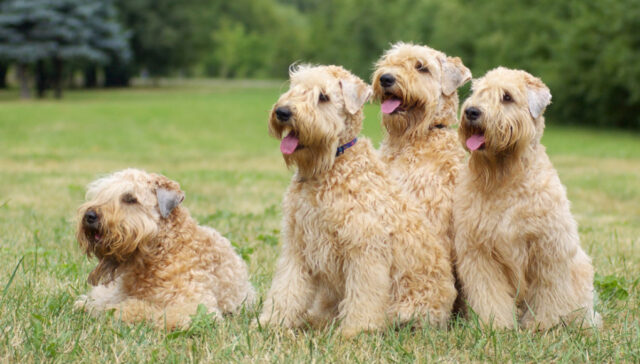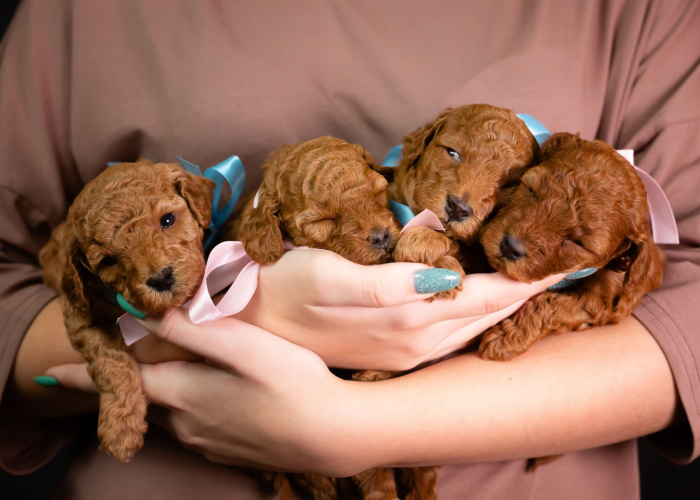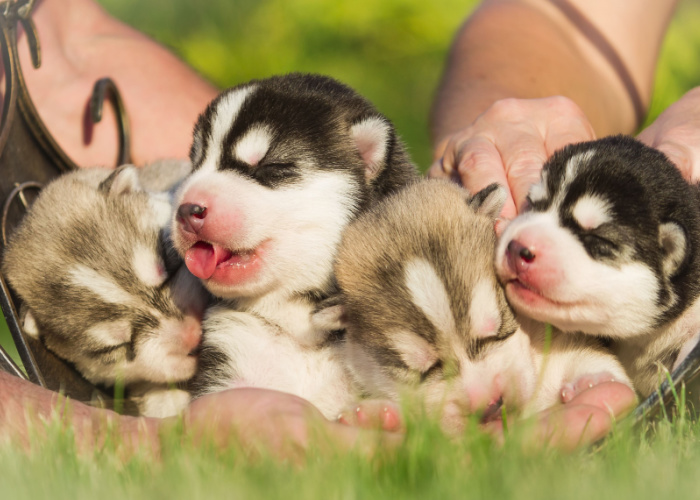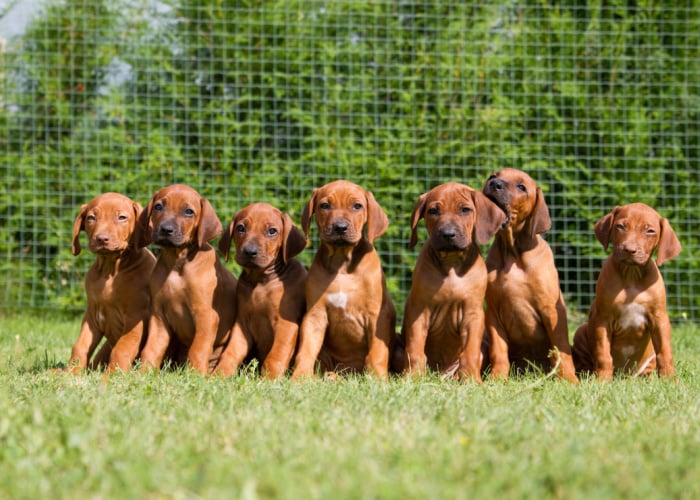
Table of Contents
Whatever reason you may have about dog breeding, you’ve come to the right place.
That’s because many vets, breeders, and pup lovers regard this topic as highly controversial.
Let’s begin pondering what experts have to say about linebreeding vs. inbreeding dogs.
Dr. Erin Chu, a Senior Veterinary Geneticist at Embark, a Boston-based dog DNA testing company, reminds that:
Breeders need to ensure that the dogs they choose to mate maintain diversity in their lineages to preserve healthy and successful breeds.
It’s unfortunate but the cons of inbreeding and linebreeding dogs weigh heavier than the positive outcomes.
So, before we get to the bottom of this, refer to this guide to easily navigate through the page:
- Spotting the difference between linebreeding and inbreeding dogs
- Advantages and disadvantages of linebreeding and inbreeding
- 10 Popular dog breeds that are mostly inbred

Linebreeding vs Inbreeding Dogs: Spotting the Difference
| Inbreeding | Linebreeding |
| Mating same-breed dogs that are closely related. | Mating same-breed dogs that are distantly related to lock in specific or desirable traits. |
| Breeding of dogs that can be father to daughter, mother to son, and brother to sister. | Half-sib mating (half-brother to half-sister) is a common form of linebreeding. |
As shown in the table above, linebreeding vs. inbreeding dogs don’t have a remarkable difference at all.
Linebreeding is also inbreeding; only a highly strategized one than the latter.
So, it’s safe to say that mating dogs, whether inbred or line-bred, depends on the breeder’s discretion.
Helpful: Outcrossing is the mating of unrelated, same-breed dogs while crossbreeding refers to mating dogs of 2 different breeds.
Advantages of Linebreeding and Inbreeding Dogs
The science of inbreeding and linebreeding dogs began many years ago and has attracted many breeders today.
Let’s find out below the most compelling reasons why.
1. Uniformity
The greater the degree of homozygosity of an animal's genome, the more uniform its offspring will be…
Carol Beuchat, Ph.D. of the Institute of Canine Biology states that Inbreeding increases homozygosity.
In genetics, homozygosity refers to an organism that has two copies of the same allele or the pairing of 2 ‘like’ genes in gene pairs.
As a result, there are fewer variations of puppies in a single litter.
The inbred dog parent, on the other hand, will become prepotent or have the ability to produce offspring with similar physical traits.
2. Pass desirable traits to offspring
Since inbreeding and linebreeding your dogs can achieve uniformity, the ability to pass outstanding traits to their offspring is also possible.
For example, the German Shepherd dog’s proud stance or the French Bulldog’s prominent facial structure is a gem to many breeders.
If your dog is from a champion bloodline, you might get popular for it.
Champion bloodlines are your dog’s lineage of ancestors that hold titles and awards from recognized competitions.
Interesting: Cross-Breeding of Dogs and Wolves Has Forever Changed Wolf’s Gene Pool

Disadvantages of Linebreeding and Inbreeding Dogs
The truth is that various studies have shown the disadvantages of linebreeding and inbreeding dogs.
Let’s learn them one by one.
1. Inbreeding depression in dogs
The so-called inbreeding depression is the negative effect of breeding closely related dogs.
Inbreeding depression often includes inherited health problems in dogs, especially a decrease in the following aspects:
- Lifespan
- Fertility rate and litter size
- Genetic diversity and variation
Over 75% of all inherited disorders in dogs are not associated with breed standards.
Rather, it has something to do with the “breed formation and small effective population size, the repeated use of popular sires and inbreeding.”
Helpful: Dam refers to the female parent dog while sire is the male.
Related: How Selective Breeding in German Shepherds Leads to Bad Health
2. Breeding for aesthetics at the pup’s expense
Another point to ponder from this study is the “shift towards dogs as a companion rather than working animals.”
This trend has resulted in certain changes in breed characteristics, especially:
...with breeding being focused towards an aesthetic rather than working or cognitive ability.
English Bulldogs, for example, have “little in common with the athletic build of their sporting ancestors.”
Due to the “exaggerated phenotypes” or traits of this dog breed, it’s unfortunate that the Bulldog’s survival is only “dependent on human intervention.”
Not to mention, 94% of births in similar dog breeds require Caesarean sections to deliver litters due to their head size.
3. Sire syndrome
“Breeders should be concerned about genetic diversity, because there are examples where damage has been done to a breed due to breeding practices.”
—Jerold S. Bell, DVM, Department of Clinical Sciences at Tufts Cummings School of Veterinary Medicine
Dr. Bell also points out that the obvious culprit in the loss of genetic diversity is the so-called sire syndrome.
This means only one male (sire) is used in an impractical amount of matings.
If this is the case breeders rely on, there is a lower chance of quality genes that male dogs can contribute to a litter of puppies.
In a study, the cause of the decrease in reproductive performance in male dogs is associated with inbreeding.
The results of the study show the following details of the reproductive ability of inbred vs. outbred male dogs:
(1) A breeding program utilizing dogs with inbreeding coefficients ranging from .125-.558 can experience reduced reproductive performance
(2) A portion of the infertility associated with conception may be attributed to the male, since inbred studs produced lower quality ejaculates compared to outbred counterparts.
Related: 19 Dogs Removed from Breeding Facility with Deplorable Conditions

10 Popular Dog Breeds That Are Mostly Inbred
Despite the red flags that inbreeding is known for, many breeders still practice this method, especially in popular dogs such as the following:
1. Norwegian Lundehund
Also known as the Puffin dog, the Norwegian Lundehund is native to the Islands in Northern Norway.
The breed’s petite build enabled it to easily hunt puffin birds and their eggs, which are usually located on steep cliffs.
One intriguing and head-turning feature of the Norwegian Lundehund dog is its 6 cute toes, which is referred to as polydactyly or polydactylism.
Four of those toes are forward pointing while the other 2 are facing inward.
This feature helps Lundehund dogs to hunt easily and get a strong grip on slippery cliffs looking for Puffin birds.
But just like the other canine breeds on this list, the Norwegian Lundehund dog is a popular subject of inbreeding.
This often results in inherited health issues such as bowel disorders or the so-called Lundehund syndrome.
2. Golden Retriever
Undeniably one of the most popular dog breeds in America — if not the world — is the ever-loving and friendly Golden Retriever.
Originating in Scotland, Goldies are medium-sized sporting breeds that can run as fast as wolves.
Yup, this seemingly gentle playful pup can become quite competitive when it comes to fierce competitions and fancy dog shows.
Not only are Goldies both intelligent and loving, but they are also very hardworking.
But because of careless breeding practices, Golden Retrievers are prone to the following health problems:
- Cancer
- Hot Spots
- Eye conditions
- Heart problems
- Hypothyroidism
- Atopic dermatitis (Atopy)
- Elbow and hip dysplasia
3. Boxer
It’s hard not to love Boxer dogs, isn’t it?
With their goofy looks and mesmerizing, pleading eyes, the Boxer pup’s charisma is hard to resist.
Unfortunately, inbreeders, too.
One reason why inbreeders or line-breeders prefer breeding Boxer dogs with close relatives is to preserve the distinct 3-color trait:
- Fawn
- White
- Brindle (a tawny color with other streaks of colors)
This characteristic can only be seen, especially in purebred ones.
Not just that, the Boxer dog’s unique head shape and other features actually help catch its prey.
| Feature | Uses |
| Short snout and undershot jaw | Power bite and hold their prey up close |
| Squished nostrils | Help them breathe while clamping down on their prey |
| Wrinkles on their face | Prevents blood from getting into their eyes |
Because of bad breeding practices, Boxer dogs are prone to various inherited health disorders such as the following:
- Canine acne
- Aortic stenosis
- Atrial septal defect
- Allergic skin disease
- Seasonal flank alopecia
- Dilated cardiomyopathy
- A non-itchy hair loss on the flanks
- Hypothyroidism (underactive thyroid gland)
4. Labrador Retriever
One of the most popular dogs in America, the Labrador Retriever is another breed that families and—well—inbreeders love.
If you’ve owned a Lab or known one, they adore the waters too well.
But did you know? Labrador Retrievers were bred to help fishermen back in the day.
That’s why Labs have double coats and webbed paws to make it easier for them to swim.
But since this swimming dog breed is often inbred, there are various genetic disorders that you may encounter or notice:
- Degenerative Myelopathy
- Skeletal Dysplasia 2 (SD2)
- Narcolepsy (sleeping disorder)
- Exercise-Induced Collapse (muscular disorder)
- Congenital Myasthenic Syndrome (muscle fatigue)
5. Springer Spaniel
The Springer Spaniel is another popular dog that any family would welcome into their homes.
But apart from their loving personality, Springers are great at sniffing, too.
They’re also used by the police force to help search for drugs, explosives, and guns.
Unfortunately, because of inbreeding and other breeding anomalies, it’s not uncommon to see weird-looking Springer Spaniels.
You might encounter a Springer with a squished face, a curved spinal cord, or a bizarre walking style.
Apart from that, normal-looking yet inbred Springer Spaniels are also vulnerable to inherited health disorders such as the following:
- Obesity
- Diabetes
- Ear problems
- Eye problems
- Heart disease
- Dental disease
- Bleeding disorders
- Patient ductus arteriosus
6. Basset Hounds
This dog breed isn’t just a household favorite; America’s first president owned one, too!
The Basset Hound was a gift for George Washington by a friend, Lafayette, following the revolution.
It is thought that because of this circumstance, Basset Hounds were referred to as old Virginia Beach bench-legged beagles.
Besides that interesting piece of history, this short-legged dog breed hasn’t escaped the hands of inbreeders, too.
Due to breeding with close relatives, Basset Hounds are prone to various painful joint and limb diseases such as the following:
- Panosteitis
- Hip dysplasia
- Elbow dysplasia
- Angular limb deformities
- Intervertebral disc disease (IVDD)
- Osteochondritis Dissecans (OCD)
7. Dachshund
Well, the Dachshund dogs are easily recognizable breeds because of their short legs.
But did you know?
Dachshunds originally had longer legs; not as long as other canine breeds but not as short as what you see today.
Inbreeding, unfortunately, is thought to have caused this condition in these dogs.
Not only that, it is common for Dachshund dogs to have health disorders such as the following:
- Diabetes
- Osteoporosis
- Urinary tract problems
- Ehlers-Danlos syndrome
- Excessive hardening of the long bones
- Achondroplasia (a genetic bone disease)
- Renal hypoplasia (problem of the kidneys)
Another trivia: A dachshund named Winnie is the first dog in the UK to be successfully cloned. The clone, Mini Winnie, was born in Seoul, Korea, and gave birth to 2 healthy puppies 4 years later in the UK.
8. German Shepherd
The German Shepherd dog’s (GSD) well-roundedness is another reason why it’s popularly inbred today.
Not only are GSDs great companion dogs, but many industries also benefit from their skill like the following:
- Guard dogs
- Mine and bomb-sniffing dogs
- Support or guide dogs for the sick, blind, and the elderly
There’s no wonder, German Shepherd dogs are one of the smartest canine breeds in the world.
During World War I, the German army used GSDs for various tasks.
The dog’s loyalty, tenacity, and intelligence made the breed Germany's most common military dog, which gained fame in the UK and America since then.
Unfortunately, due to bad breeding practices and inbreeding, GSDs are prone to the following health disorders:
- Hip dysplasia
- Excessive aggression
- Degenerative myelopathy
- Pancreatic acinar atrophy
9. Beagle
Whether inbred or line-bred, this popular dog breed is another easy target for breeders.
The Beagle dog’s promising traits are one of the many reasons why.
Friendly, sociable, and a great companion dog, Beagles are well-loved by many.
This versatile dog breed is also known for its white-tipped tail which is considered to be helpful to hunters.
Plus, the Beagle dog’s long floppy ears are a great addition to their sense of smell.
Their saggy ears create micro air currents that stir up scent molecules, funneling the scent towards their noses.
While these traits are desirable, Beagle dogs are often subjects of many health disorders as a result of inbreeding.
If you have inbred or line-bred Beagle dogs, watch out for the following health problems that they may acquire:
- Obesity
- Allergies
- Epilepsy
- Cherry eye
- Hypothyroidism
10. Rhodesian Ridgeback
This mighty dog is the only breed in the world that can keep the king of the jungle at bay.
Yup, you read that right.
Rhodesian Ridgebacks were once bred to hunt lions.
They’ve earned a nickname for it — African Lion dogs.
Note: Ridgebacks don’t literally fight lions or engage in hunting alone.
Instead, they bark and circle the king of the jungle in packs until human hunters step in.
Besides that, Rhodesian Ridgeback dogs have a distinct fur pattern on their back which they inherited from their now-extinct ancestor, the Hottentot dog.
They’re also remarkably silent dogs.
However, due to inbreeding and linebreeding practices, Rhodesian Ridgeback dogs are prone to the following health conditions:
- Reproductive problems
- Multiple types of cancer
In some cases, this African lion dog can be prone to early death, too.

Linebreeding vs Inbreeding Dogs: Before You Go…
Some breeding practices allow for positive purposes and functions in the canine circle.
Responsible breeding helps prevent certain dog breeds from going extinct or preserve desirable traits and skills.
But because not all breeders are meticulously regulated by authorities, some continue to operate without taking into account the consequences at the dog’s expense.
So, in this blog, I presented the clear line between linebreeding vs inbreeding dogs.
Which one should I recommend?
Well, at Top Dog Tips, we strongly advocate for proper and responsible breeding.
Found this article helpful?
We’ve got some top picks below!












